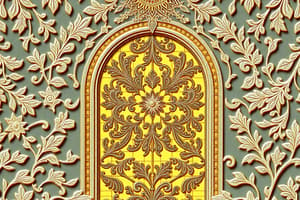Podcast
Questions and Answers
What does LASER stand for?
What does LASER stand for?
- Light Activation by Stimulus Emission of Radiation
- Laser Application through Stimulated Energy Release
- Light Amplification by Stimulated Emission of Radiation (correct)
- Light Absorption through Stimulated Energy Radiation
CO2 lasers are best suited for cutting metal only.
CO2 lasers are best suited for cutting metal only.
False (B)
What is the main advantage of using laser machining in industrial applications?
What is the main advantage of using laser machining in industrial applications?
High precision and quality of products
CO2 lasers emit light primarily at a wavelength of around _____ μm.
CO2 lasers emit light primarily at a wavelength of around _____ μm.
Match the type of laser to its primary use:
Match the type of laser to its primary use:
Which feature is NOT a characteristic of laser machining?
Which feature is NOT a characteristic of laser machining?
The conversion efficiency of CO2 lasers is higher than that of other laser types.
The conversion efficiency of CO2 lasers is higher than that of other laser types.
What future development is mentioned for laser cutting technology?
What future development is mentioned for laser cutting technology?
Flashcards are hidden until you start studying
Study Notes
Laser Technology
- Lasers are a non-traditional energy source that are finding increasing use in industrial machining.
- Laser-machined parts offer superior dimensional tolerances, accuracy, and low heat-affected zones.
- Most laser-cutting machines are equipped with CNC controls to ensure quality and timely output.
- The intensity of the laser beam can be adjusted to cut or engrave a variety of materials.
- CNC-controlled laser engraving eliminates the need for resistive masks.
- The CNC system precisely controls the laser beam's path.
Types of Laser Cutting Machines
- CO2 lasers are suitable for cutting, boring, and engraving.
- Nd lasers are used for boring and applications requiring high energy but low repetition rates.
- Nd:YAG lasers are employed when very high power is needed, particularly for boring and engraving.
CO2 Lasers
- CO2 lasers are the most commonly used in material processing.
- They emit infrared radiation at 10.6 μm (classic wavelength).
- Lower wavelengths are now used to process specific polymers.
- CO2 lasers offer high average power output ranging from a few Watts up to 50 kW.
- CO2 lasers find applications in the automotive industry and steel parts manufacturing.
- CO2 lasers are also ideal for industrial marking, annealing, engraving, or welding metals, plastics, or wood (where applicable).
- CO2 lasers offer excellent beam quality but have lower electrical-to-optical efficiency.
Applications of Laser Cutting
- Cutting, boring, and engraving metals and other materials.
- Marking and annealing materials.
- Industrial applications in various industries.
- Custom applications such as greeting cards and limited edition products.
Future Scope of Laser Cutting
- Integration of design software (e.g., SolidWorks) to provide a graphical user interface and automate part program generation.
- Expansion of the machine's working area.
Studying That Suits You
Use AI to generate personalized quizzes and flashcards to suit your learning preferences.




